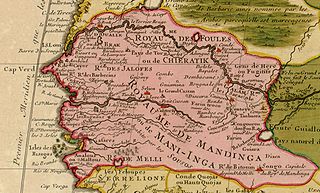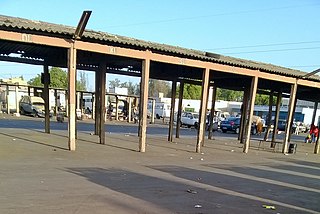
Senegal, officially the Republic of Senegal, is a country in West Africa. Senegal is bordered by Mauritania in the north, Mali to the east, Guinea to the southeast, and Guinea-Bissau to the southwest. Senegal nearly surrounds The Gambia, a country occupying a narrow sliver of land along the banks of the Gambia River, which separates Senegal's southern region of Casamance from the rest of the country. Senegal also shares a maritime border with Cape Verde. Senegal's economic and political capital is Dakar.

The history of Senegal is commonly divided into a number of periods, encompassing the prehistoric era, the precolonial period, colonialism, and the contemporary era.

Senegal's economy is driven by mining, construction, tourism, fishing and agriculture, which are the main sources of employment in rural areas, despite abundant natural resources in iron, zircon, gas, gold, phosphates, and numerous oil discoveries recently. The economy of Senegal gains most of its foreign exchange from fish, phosphates, groundnuts, tourism, and services. As one of the dominate parts of the economy, the agricultural sector of Senegal is highly vulnerable to environmental conditions, such as variations in rainfall and climate change, and changes in world commodity prices.

The Senegal River is a 1,086 km (675 mi) long river in West Africa that forms the border between Senegal and Mauritania. It has a drainage basin of 270,000 km2, a mean flow of 680 m3/s, and an annual discharge of 21.5 km3. Important tributaries are the Falémé River, Karakoro River, and the Gorgol River. The river divides into two branches once it passes Kaédi The left branch, called the Doué, runs parallel to the main river to the north. After 200 km the two branches rejoin a few kilometers downstream of Pondor.

Dakar is the capital and largest city of Senegal. The city of Dakar proper has a population of 1,030,594, whereas the population of the Dakar metropolitan area is estimated at 2.45 million.

French West Africa was a federation of eight French colonial territories in Africa: Mauritania, Senegal, French Sudan, French Guinea, Ivory Coast, Upper Volta, Dahomey and Niger. The federation existed from 1895 until 1958. Its capital was Saint-Louis, Senegal until 1902, and then Dakar until the federation's collapse in 1960.

Saint Louis or Saint-Louis, known to locals as Ndar, is the capital of Senegal's Saint-Louis Region. Located in the northwest of Senegal, near the mouth of the Senegal River, and 320 km north of Senegal's capital city Dakar, it has a population officially estimated at 176,000 in 2005. Saint-Louis was the capital of the French colony of Senegal from 1673 until 1902 and French West Africa from 1895 until 1902, when the capital was moved to Dakar. From 1920 to 1957, it also served as the capital of the neighboring colony of Mauritania.

Macky Sall is a Senegalese politician who has been President of Senegal since April 2012. He was re-elected President in the first round voting in February 2019 Senegalese presidential election. Under President Abdoulaye Wade, Sall was Prime Minister of Senegal from July 2004 to June 2007 and President of the National Assembly from June 2007 to November 2008. He was the Mayor of Fatick from 2002 to 2008 and held that post again from 2009 to 2012.

Senegal is subdivided into 14 regions, each of which is administered by a Conseil Régional elected by population weight at the arrondissement level. Senegal is further subdivided into 45 departments, 103 arrondissements and by collectivités locales which elect administrative officers. Three of these regions were created on 10 September 2008, when Kaffrine Region was split from Kaolack, Kédougou region was split from Tambacounda, and Sédhiou region was split from Kolda.

The Senegal national football team represents Senegal in men's international association football and it is controlled by the Senegalese Football Federation. The team's nickname is the Lions of Teranga. The team became the second African team to reach the quarter finals in the 2002 FIFA World Cup after Cameroon in 1990 and losing to Turkey in extra time and The team represents both FIFA and Confederation of African Football (CAF).

The Prime Minister of Senegal was the head of government of Senegal. The Prime Minister was appointed by the President of Senegal, who is directly elected for a seven-year term. The Prime Minister, in turn, appointed the Senegalese cabinet, after consultation with the President. On 14 May 2019, the post was abolished.

The National Assembly is the unicameral legislature of Senegal. The Assembly was previously part of a bicameral legislature from 1999 to 2001 and from 2007 to 2012, with the indirectly elected Senate being the upper house. The Senate was abolished for a second time in September 2012.

The Senegalese Football Federation (FSF) is the governing body of football in Senegal. It was founded in 1960, affiliated to FIFA in 1964 and to CAF in 1963. It organizes the national football league and the national team.

The cuisine of Senegal is a West African cuisine influenced by North African, French, and Portuguese cuisine and derives from the nation's many ethnic groups, the largest being the Wolof. Islam, which first penetrated the region in the 11th century, also plays a role in the cuisine. Senegal was a colony of France until 1960. Ever since its colonization, emigrants have brought Senegalese cuisine to many other regions.

Senegal–United States relations are bilateral relations between Senegal and the United States.

Sadio Mané is a Senegalese professional footballer who plays as a winger for Premier League club Liverpool and the Senegal national team.
Miss-Sénégal is a national Beauty pageant in Senegal.

India–Senegal relations are bilateral diplomatic relations between India and Senegal. India maintains an embassy in Dakar and Senegal in New Delhi. Although people to people contacts have been limited, the two countries enjoy warm relations and in recent years trade and investment have been increasing steadily.

The COVID-19 pandemic in Senegal is part of the worldwide pandemic of coronavirus disease 2019 caused by severe acute respiratory syndrome coronavirus 2. The virus was confirmed to have reached Senegal on March 2, 2020.














